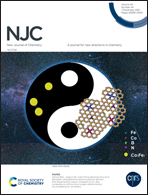Boosting the electrochemistry of Li2O2 in lithium–oxygen batteries by plasmon-induced hot-electron injection†
Abstract
A photo-assisted Li–oxygen (Li–O2) battery with Au/SnO2 (ASO) hybrid nanotubes as the cathode and photocatalyst has been prepared. The localized surface plasmon resonance (LSPR) excitation of gold nanoparticles (Au NPs) can dramatically improve the oxygen reduction reaction (ORR) and oxygen evolution reaction (OER) of Li–O2 batteries. The photoelectrons generated via LSPR can be transferred to the conduction band (CB) of SnO2 for facilitating the reduction of O2 to form Li2O2 through the ORR, in a discharge process with illumination. Conversely, the holes left in Au NPs can promote Li2O2 oxidation in a charging process with illumination. With illumination, a 2.36 times higher discharge capacity of up to 10705.2 mA h g−1 is observed and the discharged product (Li2O2) can be decomposed completely due to LSPR. The discharge voltage can be obviously enhanced to 3.10 V, significantly exceeding the equilibrium voltage of 2.96 V, and the charge voltage is decreased to 3.59 V. This work provides a new strategy for the decomposition of Li2O2 by improving the efficiency of charge transfer dynamics and the mechanism of LSPR in the photo-assisted (Li–O2) battery.



 Please wait while we load your content...
Please wait while we load your content...